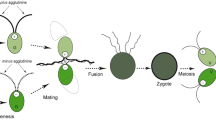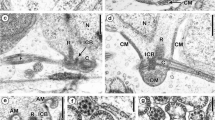Summary
Sex-specific agglutination in gametes ofChlamydomonas eugametos was carried out with dead partner cells (killed by glutaraldehyde, formaldehyde or OsO4), with isolated flagella, flagellar appendages and isoagglutinins derived from cell-free culture medium. The activation of the plasma papilla in agglutinated cells was studied by scanning electron microscopy in relation to the agglutinative properties of the materials tested. The results reveal differences in agglutination and papilla activation between gametes of both mating types. They also indicate that papilla activation depends on the extent of agglutination, which is a function of sex-specific flagellar properties and the amount and nature of the agglutinative material used. A hypothesis is presented to explain the observed phenomena.
Similar content being viewed by others
References
Bergman, K., Goodenough, U. W., Goodenough, D. A., Jawitz, J., Martin, H., 1975: Gametic differentation inChlamydomonas reinhardii. II. Flagellar membranes and the agglutination reaction. J. Cell Biol.67, 606–622.
Bloodgood, R. A., 1977: Motility occurring in association with the surface of theChlamydomonas flagellum. J. Cell Biol.75, 983–989.
Bourguignon, L. Y. W., Singer, S. J., 1977: Transmembrane interactions and the mechanism of capping of surface receptors by their specific ligands. Proc. nat. Acad. Sci. (U.S.A.)74, 5031–5035.
Brown, M. R., Jr., Johnson, C. O. P., Bold, H. C., 1968: Electron and phasecontrast microscopy of sexual reproduction inChlamydomonas moewusii. J. Phycol.4, 100–120.
Edelman, G. M., 1976: Surface modulation in cell recognition and cell growth. Some new hypotheses on phenotypic alteration and transmembranous control of cell surface receptors. Science192, 218–226.
Goodenough, U. W., 1977: Mating interactions inChlamydomonas. In: Microbial interactions (Receptors and Recognition, Series B, Volume 3) (Reissig, J. L., ed.), pp. 324–350. London: Chapman and Hall.
Koch, G. L. E., Smith, M. J., 1978: An association between actin and the major histocompatibility antigen H-2. Nature273, 274–278.
Lewin, R. A., 1952: Studies on the flagellar of algae. I. General observations onChlamydomonas moewusii Gerloff. Biol. Bull.102, 74–79.
Løvlie, A., Bryhni, E., 1976: Signal for cell fusion. Nature263, 779–781.
Lutz, H. U., Lui, S., Palek, J., 1977 a: Release of spectrin-free vesicles from human erythrocytes during ATP depletion. J. Cell Biol.73, 548–560.
—,Lomant, A. J., McMillan, P., Wehrli, E., 1977 b: Rearrangements of integral membrane components duringin vitro aging of sheep erythrocyte membranes. J. Cell Biol.74, 389–398.
McLean, R. J., Laurendi, C. J., Brown, M. R., Jr., 1974: The relationship of gamone to the mating reaction inChlamydomonas moewusii. Proc. nat. Acad. Sci. (U.S.A.)71, 2610–2613.
Mesland, D. A. M., 1976: Mating inChlamydomonas eugametos. A scanning electron microscopical study. Arch. Microbiol.109, 31–35.
—, 1977: Flagellar surface morphology ofChlamydomonas eugametos. Protoplasma93, 311–323.
De Petris, S., 1978: Preferential distribution of surface immunoglobulins on microvilli. Nature272, 66–68.
Snell, W. J., 1976: Mating inChlamydomonas: a system for the study of specific cell adhesion. J. Cell Biol.66, 48–69.
Solter, K. M., Gibor, A., 1977: Evidence for role of flagella as sensory transducers in mating ofChlamydomonas reinhardii. Nature265, 444–445.
Triemer, R. E., Brown, M. R., Jr., 1975: The ultrastructure of fertilization inChlamydomonas moewusii. Protoplasma84, 315–325.
Tschermak-Woess, E., 1963: Das eigenartige Kopulationsverhalten vonChloromonas saprophila, einer neuen Chlamydomonacee. Österr. Botan. Z.110, 294–307.
Tsubo, Y., 1961: Chemotaxis and sexual behaviour inChlamydomonas. J. Protozool.8, 114–121.
Weiss, R. L., Goodenough, D. A., Goodenough, U. W., 1977: Membrane differentiation at sites specialized for cell fusion. J. Cell Biol.72, 144–160.
Wiese, L., 1965: On sexual agglutination and mating-type substances (gamones) in isogamous heterothallic Chlamydomonads. I. Evidence of the identity of the gamones with the surface components responsible for sexual flagellar contact. J. Phycol.1, 46–54.
—, 1974: Nature of sex-specific glycoprotein agglutinins inChlamydomonas. Ann. N.Y. Acad. Sci.234, 383–395.
Witman, G. B., Carlson, K., Berliner, J., Rosenbaum, J. L., 1972:Chlamydomonas flagella. I. Isolation and electrophoretic analysis of microtubules, matrix, membranes and mastigonemes. J. Cell Biol.54, 507–539.
Author information
Authors and Affiliations
Rights and permissions
About this article
Cite this article
Mesland, D.A.M., van den Ende, H. The role of flagellar adhesion in sexual activation ofChlamydomonas eugametos . Protoplasma 98, 115–129 (1979). https://doi.org/10.1007/BF01676665
Received:
Accepted:
Issue Date:
DOI: https://doi.org/10.1007/BF01676665




